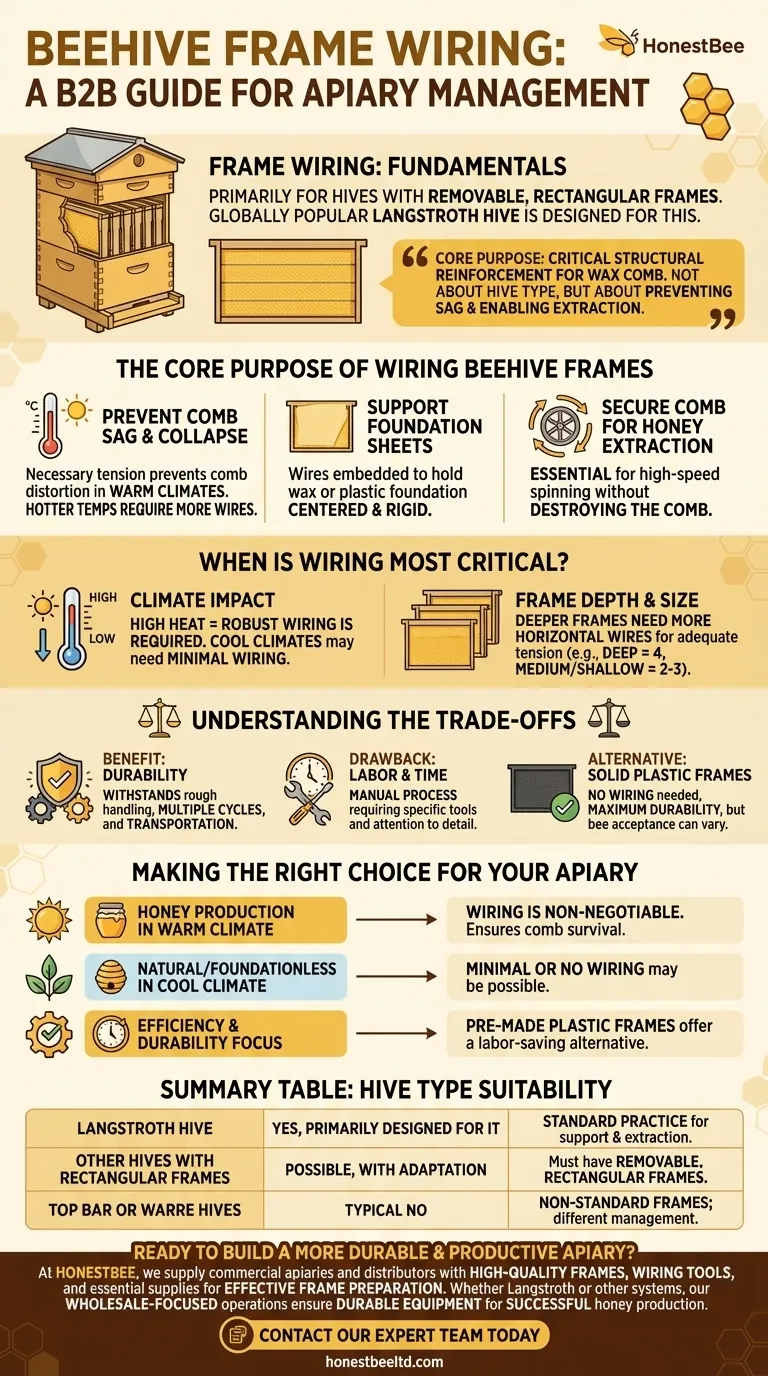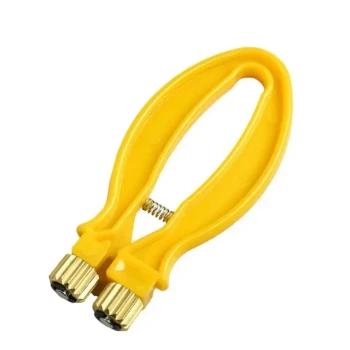In short, frame wiring is a technique primarily used for beehives with removable, rectangular frames. This includes the globally popular Langstroth hive, which is designed specifically for this practice. While it can be adapted for other hive types with similar frames, it is most fundamentally associated with systems that require structural support for foundation or drawn comb.
The core purpose of wiring is not about the type of hive, but about providing critical structural reinforcement to the wax comb. This prevents sagging in warm climates and provides the strength needed for high-speed honey extraction.

The Core Purpose of Wiring Beehive Frames
Wiring serves as an internal skeleton for the beeswax, ensuring the comb remains stable and usable for both the bees and the beekeeper. This structural integrity is vital for several key reasons.
Preventing Comb Sag and Collapse
In warm climates, beeswax can soften and stretch under the weight of honey and brood. Wiring provides the necessary tension to hold the comb in place, preventing it from sagging, distorting, or detaching from the frame entirely.
The hotter the ambient temperature, the more critical this support becomes. Beekeepers in southern regions often use more wires per frame than those in cooler, northern areas.
Supporting Foundation Sheets
Beekeepers often use sheets of beeswax or plastic foundation to guide the bees in building straight comb. Wires are embedded into this wax foundation to hold it perfectly centered and rigid within the frame.
Without this support, the foundation can warp or bow, leading to poorly drawn comb that is difficult to manage and inspect.
Securing Comb for Honey Extraction
During honey harvesting, frames are placed in a centrifugal extractor that spins at high speeds. Wiring is essential to prevent the comb from blowing apart under these intense forces, allowing for efficient honey removal without destroying the bees' work.
When is Wiring Most Critical?
The decision to wire frames depends less on the specific hive model and more on environmental factors and your beekeeping goals.
The Impact of Climate
As noted, temperature is the single most important factor. In areas where hives are exposed to high heat, the wax is perpetually at risk of softening. In these regions, robust wiring is not optional; it's a requirement for hive stability.
In cooler climates, some beekeepers can get by with minimal wiring or even foundationless frames, as the comb remains more rigid year-round.
Frame Depth and Size
The physical dimensions of the frame also dictate the need for support. Deeper frames require more horizontal wires to provide adequate tension across the entire surface of the comb.
A deep Langstroth frame might use four strands of wire, whereas a medium or shallow frame might only need two or three.
Understanding the Trade-offs
While beneficial, wiring is a specific management choice with its own set of considerations. It is not the only way to manage frames.
The Benefit: Durability
Wired frames are exceptionally durable. They withstand rough handling, multiple extraction cycles, and the stresses of transportation, making them a long-term investment.
The Drawback: Labor and Time
Wiring frames is a manual process that adds a significant amount of upfront work when setting up new equipment. It requires specific tools and attention to detail to achieve the correct tension.
The Alternative: Solid Plastic Frames
Many beekeepers now opt for solid plastic frames that come with a pre-molded hexagonal cell pattern. These frames require no wiring and offer maximum durability, though some beekeepers feel the bees are slower to accept them compared to natural beeswax.
Making the Right Choice for Your Apiary
Ultimately, the need for wiring is determined by your specific context and goals.
- If your primary focus is honey production in a warm climate: Wiring is a non-negotiable step to ensure your combs survive the heat and the extractor.
- If your primary focus is natural, foundationless beekeeping in a cool climate: You may be able to successfully manage your hives with minimal or no wiring.
- If your primary focus is efficiency and durability: Pre-made plastic frames offer a labor-saving alternative that achieves the same structural integrity as wiring.
Choosing the right frame preparation method is a foundational decision that will impact your hive management for years to come.
Summary Table:
| Hive Type | Suitable for Wiring? | Key Considerations |
|---|---|---|
| Langstroth Hive | Yes, primarily designed for it | Standard practice for structural support and extraction. |
| Other Hives with Rectangular Frames | Possible, with adaptation | Must have removable, rectangular frames similar to Langstroth. |
| Top Bar or Warre Hives | Typically No | Frames are not standard; different comb management is used. |
Ready to build a more durable and productive apiary?
At HONESTBEE, we supply commercial apiaries and beekeeping equipment distributors with the high-quality frames, wiring tools, and other essential supplies needed for effective frame preparation. Whether you manage Langstroth hives or other systems, our wholesale-focused operations ensure you get the durable equipment required for successful honey production and comb management.
Contact our expert team today to discuss your specific needs and learn how we can support your beekeeping success.
Visual Guide

Related Products
- Plastic Bee Frame Beekeeping Hive Frames for Wholesale
- Assembled Wooden Bee Frames with Beeswax Foundation Ready to Use by HONESTBEE
- HONESTBEE Wired and Assembled Wooden Bee Frames Foundation for a Thriving Hive
- Stainless Steel 9 Frame Hive Spacer Durable Precise for Commercial Beekeeping
- Heavy-Duty Stainless Steel Clip-On Frame Perch
People Also Ask
- What are the differences between wooden and plastic frames in beehives? Choose the Best for Your Apiary
- Are plastic frames good? Boost Apiary Efficiency with Durable, Pest-Resistant Frames
- What is a general rule for beekeepers with many hives regarding frame choice? Maximize Efficiency with Plastic Frames
- Can you boil plastic bee frames? Avoid This Costly Mistake and Protect Your Hive
- Are plastic bee hive frames good? A Guide to Modern Durability vs. Natural Appeal



















